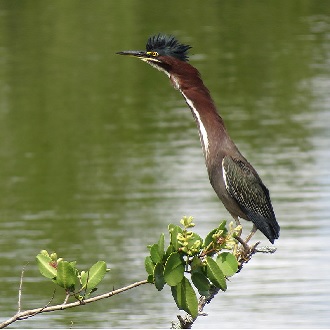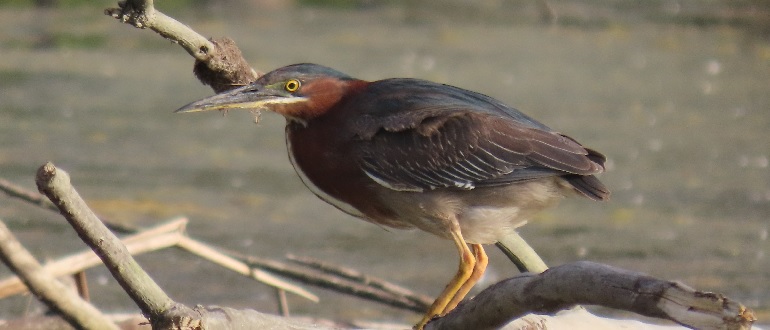Hide & Seek! Can you find me?
GET TO KNOW
green herons
Catching a glimpse of a green heron is a rare treat! They are shy, solitary birds that spend most of their time hiding in the foliage at the edges of streams and ponds. Since green herons fall prey to larger hawks and eagles, hiding is a pretty good survival strategy.
FUN FACT:
Like all herons, Green herons are wading birds that hunt in shallow waters to find food. These birds have very little webbing on their feet and are rarely seen swimming. However, when the need arises, green herons (and other herons) are capable of making deep dives and paddling on the surface of the water (much like a duck).
Unfortunately, hiding also reduces a bird lover’s chance of spotting this wonderful little heron.
PHYSICAL CHARACTERISTICS
As a member of the butorides genus of small herons, Green herons have short legs and spend their days hunting in shallow waters near the banks. Butorides also have short, thick necks and look awkwardly unbalanced when they stretch out to look around.

Fully grown green herons are about the size of crows (16 – 18 in.) with an average wingspan of 26 inches. They have a dark grey back, wings, and feather cap with a reddish chest. They only appear greenish in strong sunlight, where their dark grey feathers give off a green shimmer. When startled and alarmed, green herons fluff up their feather cap into a small crest. As with many birds, female green herons are slightly smaller with duller colors.
Green Herons are carnivores who hunt by fishing. They primarily eat fish, crustaceans, frogs, and aquatic insects. They are known to use small items (insects, small twigs, feathers, etc.) as bait/lures to attract fish. The heron uses its strong bill to place the bait on the surface of the water to catch the attention of a fish. With remarkable speed and accuracy, the heron strikes out and snatches any fish unlucky enough to approach the bait. And while green herons prefer fish, they are certainly not picky. If hungry enough, they will also hunt on land for snakes, large insects and rodents.
HABITAT & LIFE CYCLE
Green Heron populations in Michigan are migratory. They visit the state during late spring and summer months for breeding purposes. (Year-round populations live along both the east and west coasts of the southern US, Mexico, and Central America.) Their preferred breeding habitats center around small bodies of fresh water with abundant trees and shrubs along shorelines.
The lifespan of green herons is estimated to be 8 years. Males select the breeding territory and begin nest construction while waiting for a mate. The male engages in ritual flight patterns over his territory to attract a lady heron. Once a mate is chosen, the female completes nest construction. In Michigan, the female lays one clutch of 2 – 8 eggs during the summer season. Eggs hatch in twenty days, and baby herons take their first flight around 17 days after hatching.
Mated pairs of green herons are monogamous during the breeding season. They work together as true partners and share all activities. Both partners actively defend the nest and territory, incubate the eggs and feed the young. Happily cared for, young herons remain in the protection of their parents for approximately 2 weeks after making a first flight. When the fall migration approaches, partners bid adieu and fly their separate ways. The cycle repeats each year with newly chosen partners.
TAKE ACTION
At this time green herons have a widespread presence across their range. There is some evidence that, due to global climate change, green herons are gradually extending their west coast range a bit northward. However, many environmental organizations have expressed concern that the number of individual green herons are declining within local populations. This concern is due to an ongoing threat of habitat loss. Since green herons require abundant marsh lands and strong riparian zones around streams and rivers for breeding and migration cycles, development in such areas can negatively affect breeding opportunities for new generations. Additionally, there is concern that man-made “replacement wetlands” created by land developers do not provide sufficient biodiversity to adequately support green heron migration/breeding needs.
You can help green herons by getting involved! Help Friends of the Rouge work to preserve and maintain healthy riparian zones within the Rouge River watershed. Additionally if you have a creek, stream or pond on your own property, be careful to maintain a healthy riparian zone of natural trees and shrubs along the waterline.
MAIN PHOTO CREDIT: Green Heron hunting in Rouge River – photo by Donna Hall – image cropped
